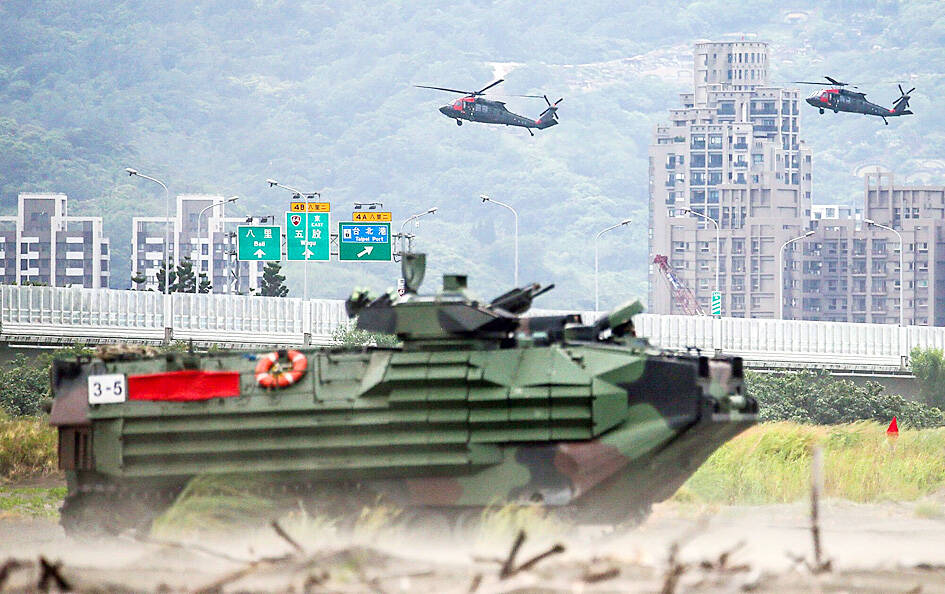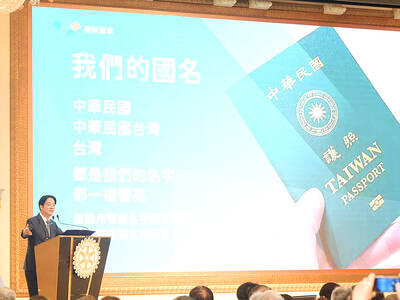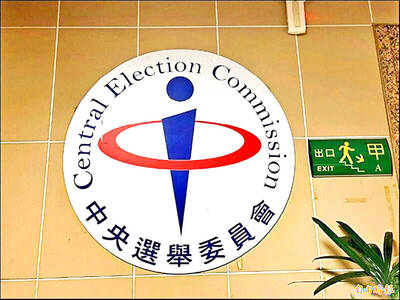The upcoming live-fire segment of Taiwan’s annual Han Kuang military exercises would focus on testing troops’ response to a decentralized command structure, the updated rules of engagement and unremitting operational scenarios, a military source said yesterday.
The Han Kuang exercises, the nation’s largest military drills, are held annually in two stages. The 40th edition this year began with the tabletop war games phase from April 19 to 26.
The live-fire exercises are scheduled to take place from July 22 to 26, the Ministry of National Defense has said.

Photo: I-Hwa Cheng, Bloomberg
This year’s live-fire exercises would prioritize testing the ability of troops to fend off an unremitting Chinese invasion, how prepared troops are to launch counterattacks based on their own judgement, and their ability to follow the updated rules of engagement, a military source said, speaking on condition of anonymity.
In previous years, the five-day live-fire portion of the exercises was primarily conducted during the day, but this year, the drills would also be held at night, as “the enemy could strike at any time of the day,” the source said.
The exercises would include a decentralized command structure, meaning units would have to make their own judgement calls after losing contact with central command, they said.
Each unit should follow the updated rules of engagement when encountering enemy troops, even when they are unable to contact central command, the source added.
Revised rules of engagement were released last year, amid repeated incursions into Taiwan’s air defense identification zone by Chinese warplanes, drones and balloons.
The rules instruct troops on which scenarios they are authorized to use weapons and ammunition to launch counterattacks, the source said.
Unlike in previous editions, there are to be fewer live-fire exercises open to the media.
The military used to give media access to parts of the exercises and invited senior government officials, including the president, to oversee them. The purpose was to keep the public informed about the latest military developments and to assure them that their troops are capable of defending the nation.
That practice serves little practical purpose in terms of preparing for war, the source said.
As a test of the armed forces’ emergency response capabilities, the military would also simulate several scenarios that could occur if a cross-strait war were to break out without prior warning, they added.
This year, the exercises would be as close as possible to actual combat given the rapidly rising “enemy threat” from China, said a senior official, speaking on condition of anonymity.
China has been staging regular exercises around Taiwan.
“In recent years, the enemy threat has changed rapidly,” the official said. “Our defense combat plan must also be continuously revised on a rolling basis, and the urgency of comprehensive combat training is becoming more important.”
Things might go wrong in the drills, such as vehicle breakdowns, which would be fine, as “these are problems that might be faced in actual combat,” they said.
The exercises would be a continuous experience, as “war does not distinguish between night and day,” the official said.
The defense ministry in April said the war games would practice “kill” zones at sea to break a blockade and simulate a scenario where China suddenly turns one of its regular drills around Taiwan into an attack.
“Only with real-time, on-the-ground verification can we truly understand the capabilities and limitations of our troops,” the official said.
China held two days of its own war games around Taiwan shortly after President William Lai (賴清德) took office on May 20, saying it was “punishment” for his inauguration speech.
China has also been using “gray zone” warfare against Taiwan, which means using irregular tactics to exhaust a foe by keeping them continually on alert without resorting to open combat.
This has included sending balloons over Taiwan and almost daily air force missions in the skies near Taiwan.
The official declined to comment on which parts of the war games Lai would attend or whether there would be US observers.

LONG FLIGHT: The jets would be flown by US pilots, with Taiwanese copilots in the two-seat F-16D variant to help familiarize them with the aircraft, the source said The US is expected to fly 10 Lockheed Martin F-16C/D Block 70/72 jets to Taiwan over the coming months to fulfill a long-awaited order of 66 aircraft, a defense official said yesterday. Word that the first batch of the jets would be delivered soon was welcome news to Taiwan, which has become concerned about delays in the delivery of US arms amid rising military tensions with China. Speaking on condition of anonymity, the official said the initial tranche of the nation’s F-16s are rolling off assembly lines in the US and would be flown under their own power to Taiwan by way

‘OF COURSE A COUNTRY’: The president outlined that Taiwan has all the necessary features of a nation, including citizens, land, government and sovereignty President William Lai (賴清德) discussed the meaning of “nation” during a speech in New Taipei City last night, emphasizing that Taiwan is a country as he condemned China’s misinterpretation of UN Resolution 2758. The speech was the first in a series of 10 that Lai is scheduled to give across Taiwan. It is the responsibility of Taiwanese citizens to stand united to defend their national sovereignty, democracy, liberty, way of life and the future of the next generation, Lai said. This is the most important legacy the people of this era could pass on to future generations, he said. Lai went on to discuss

MISSION: The Indo-Pacific region is ‘the priority theater,’ where the task of deterrence extends across the entire region, including Taiwan, the US Pacific Fleet commander said The US Navy’s “mission of deterrence” in the Indo-Pacific theater applies to Taiwan, Pacific Fleet Commander Admiral Stephen Koehler told the South China Sea Conference on Tuesday. The conference, organized by the Center for Strategic and International Studies (CSIS), is an international platform for senior officials and experts from countries with security interests in the region. “The Pacific Fleet’s mission is to deter aggression across the Western Pacific, together with our allies and partners, and to prevail in combat if necessary, Koehler said in the event’s keynote speech. “That mission of deterrence applies regionwide — including the South China Sea and Taiwan,” he

UNPRECEDENTED: In addition to the approved recall motions, cases such as Ma Wen-chun’s in Nantou are still under review, while others lack enough signatures The Central Election Commission (CEC) announced yesterday that a recall vote would take place on July 26, after it approved the first batch of recall motions targeting 24 Chinese Nationalist Party (KMT) lawmakers and Hsinchu Mayor Ann Kao (高虹安). Taiwan is in the midst of an unprecedented wave of mass recall campaigns, following a civil society push that echoed a call made by Democratic Progressive Party (DPP) caucus whip Ker Chien-ming (柯建銘) in January to initiate signature drives aimed at unseating KMT legislators. Under the Civil Servants Election and Recall Act (公職人員選舉罷免法), Taiwanese can initiate a recall of district-elected lawmakers by collecting